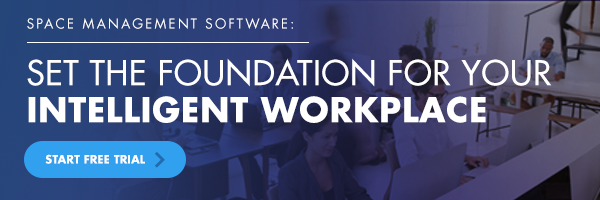Workplace Occupancy Metrics: What To Track, How & Why


Workplace leaders must walk a thin line between maximizing space occupancy and ensuring the workforce has an enjoyable environment. An office that’s too crowded won’t be comfortable for anyone, but having too much unoccupied space eats away at your bottom line.
And according to CBRE, 40-60% of all corporate real estate sits empty.
To strike the proper balance between cost-effectiveness and comfort, you need comprehensive insight into the utilization of your workplace. That means knowing more than just basic occupancy and vacancy levels.
Here are four important workplace occupancy metrics you need to know and how to track them.
4 Workplace Occupancy Metrics to Track
1. Employee-to-Workstation Ratio
In a traditional workplace where each employee has an assigned desk and comes into the office every day, the employee-to-workstation ratio would be 1:1. However, in a modern agile work environment that uses flexible work arrangements such as remote working, activity-based working, office hoteling or hot desking, there are no dedicated workstations.
If your company has implemented a flexible workplace strategy or has a large mobile workforce, your employee-to-workstation ratio should ideally be closer to 1.5:1 or 2:1.
In fact, in a report published by the Treasury Inspector General for Tax Administration, researchers found that using a 3:1 ratio for highly mobile employees and employees who frequently work remotely could eliminate over 6,600 workstations in IRS workplaces.
Considering the cost of one empty desk can be as high as $18,000 a year, that’s a potential savings of $118 million for a company of that size!
2. Peak Utilization by Space and Peak Frequency
Peak utilization by space is a measurement of the maximum number of employees using a specific workspace. You can measure peak utilization for individual workstations, quiet spaces, phone booths and communal spaces like lounges and casual meeting areas. Peak frequency is the number of times a space reaches maximum utilization over the course of a month.
Tracking peak utilization and peak frequency gives you insight into the times of day and days of the week when particular spaces are most often occupied. Comparing this information to team calendars and the company event schedule can help you better understand what factors contribute to periods of higher space utilization.
Knowing the average peak utilization by space as well as peak frequency can also help you identify circumstances where space utilization is abnormally low, which could indicate an issue with a workspace or signal a need for an adjustment.
3. Conference Room Utilization
Despite the fact that 40% of office space sits empty, 45% of employees don’t have access to the space they need, according to IoT sensor company Density. Conference room utilization is one of the most complex office space occupancy metrics because it includes several different measurements. In addition to simply capturing the times when a meeting space is occupied, measuring conference room utilization involves recording meeting sizes (i.e., number of attendees), meeting types (scheduled in advance or ad hoc) and meeting duration.
Conference room utilization is also unique because unlike workstation reservations, meeting spaces are often reserved but then not actually used for one reason or another. In addition, depending on what room scheduling tool your company uses, conference rooms are subject to double-bookings.
To calculate this important space occupancy metric, you need to factor in when rooms are:
- Reserved and occupied
- Reserved and not occupied
- Not reserved but occupied anyway
Relying on incomplete room scheduling tools like Microsoft Outlook won’t give you the full picture of your conference room utilization. Using room reservation software that integrates with IoT sensors will ensure you always have accurate, real-time data.
How to Measure Space Occupancy
The most effective way to measure space occupancy is by leveraging three powerful technologies: cloud-based space management software, room reservation software and sensors.
Space management software sets the foundation for measuring space occupancy by bringing all your floor plans into one digital, interactive, data-rich platform. With space management software, you can easily see which spaces are occupied or vacant by building, floor or department.
Room reservation software allows anyone in the workplace to book workstations or conference rooms using their desktop, mobile app or a digital room scheduling panel.
IoT sensors passively measure the occupancy of various workspaces throughout the office and provide the facilities team with accurate, real-time utilization data. The sensors integrate with both space management and room reservation software to measure and improve utilization.
These three tools give workplace leaders a complete picture of space utilization across the organization. They can use this data to make smart, data-driven decisions about which spaces are underutilized and make improvements.
The more you know about your workplace occupancy, the easier it will be to create an environment that is cost-effective and loved by your workforce.
To get a glimpse at how our space management and room reservation software work together, sign up for a five-day free trial today.
